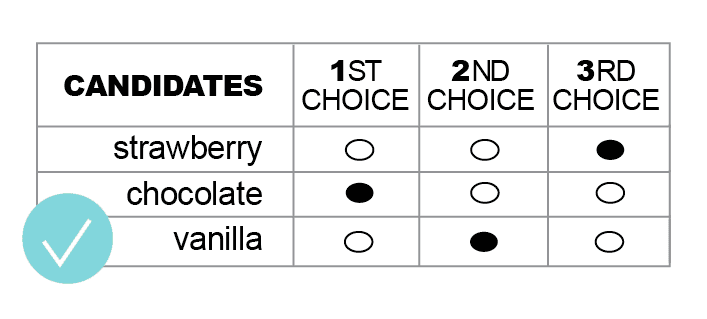FREQUENTLY ASKED QUESTIONS
Monday, November 30, 2020 | By: Ranked Choice Voting Resource Center
Share
WHAT IS RANKED-CHOICE VOTING?
Ranked-choice voting is an increasingly common election method that allows voters to rank candidates in order of choice. Those rankings ensure that as many voters as possible will help elect a candidate they support.
Ranked-choice voting has a long history of use in U.S. elections. It has been used to elect city councils in more than two dozen cities, including New York City, Cincinnati, Cleveland, Boulder, and Sacramento. It is used to elect multiple offices in Cambridge, MA, and in Minneapolis, MN, and it is used to elect single-winner offices in four cities in the Bay Area in California, the two largest cities in Minnesota, and other cities in Colorado, Maine, Minnesota, and Maryland. Five states use Ranked-choice ballots to ensure that overseas and military voters can fully express their choices in elections that may go to a runoff.
Ranked-choice voting is widely used in the English-speaking world. It is used in at least one election by every voter in Australia, Ireland, New Zealand, Northern Ireland, and Scotland. Its single-winner method is recommended by Robert’s Rules of Order for elections of officers when repeated voting is impractical and, as a result, widely used in non-governmental elections.
LEARN MORE
IS RANKED-CHOICE VOTING THE SAME AS INSTANT RUNOFF VOTING/SINGLE TRANSFERABLE VOTE/PREFERENCE VOTING/THE ALTERNATIVE VOTE?
Yes. The terms instant runoff voting, single transferable vote, preference voting, the alternative vote, all refer to ranked-choice voting.
Usually, the term instant runoff voting or IRV only refers to electing a single-winner office like mayor or governor because when used to elect one candidate, RCV allows a jurisdiction to have the benefits of multiple runoff elections, but voters only need to vote a single time.
Also, the term single transferable vote or STV usually refers to electing a multi-winner office, like a city council or legislature. It is a single vote because every voter has one vote as compared to block voting, in which voters may vote for more than one candidate if more than one will be elected. It is a transferable vote because it uses round-by-round tabulation in which votes may transfer from candidates who are elected or who are defeated in the prior round.
HOW DOES RANKED-CHOICE VOTING WORK?
Ranked-choice voting is designed to be simple for voters: rank candidates in order of choice. Voters can rank as many or as few candidates as they want to.
The votes are counted to ensure that as many voters as possible help to elect a candidate they support. In a single-winner election, like for mayor or governor, that means that ranked-choice voting helps to elect a candidate with majority support. In a multi-winner election, it means that ranked-choice voting helps a supermajority of voters elect a candidate they support by allowing smaller groups of voters to each elect one of the winners.
To see how ranked-choice voting works in detail, visit “How it Works.”
WHERE IS RANKED-CHOICE VOTING USED?
Ranked-choice voting has been adopted in U.S. cities in ten states. It is used by overseas and military voters to vote in places with runoff elections in another five states. Over 50 U.S. colleges and universities use ranked-choice voting to elect student government officers. Internationally, it is used by every voter in six countries and in local elections in many more. Ranked-choice voting is recommended for private organizations by Robert’s Rules of Order. Many private organizations use it, including the Academy Awards, to nominate and select the winner for its prestigious awards.
Visit “Where it’s Used” for a comprehensive list of jurisdictions that use ranked-choice voting.
Related Posts
Tags
advocate's guide to implementing rcv
akpol
alaskaspecialelection
audits
ballot design
best practices
budgeting
candidate education
candidates
civility in campaigns
conduct an election
conference travel
conferences
counting and certification
data clearinghouse
democracy rising
education
election
election admin
election administration






0 Comments